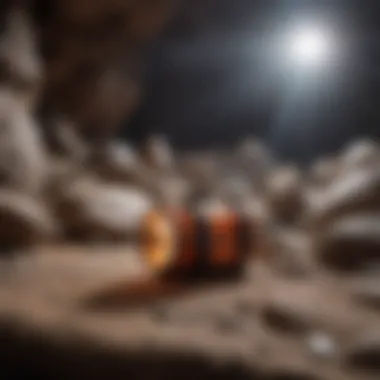Exploring Portable Ultraviolet Light: Uses and Safety


Intro
Ultraviolet (UV) light is more than just a breakdown of sunlight; it is a potent tool with remarkable applications across various domains. As technological innovations continue to rise, portable UV light devices are becoming an integral part of daily life—from disinfecting surfaces to preserving art and even supporting geological research. With its expanding usage, understanding the nuances of this technology is paramount.
Why Portable UV Light Matters
Every so often, a technology emerges that bridges gaps left by traditional methods. Think of portable UV light as that multi-tool found in the drawer of an outdoorsy friend who always seems prepared. It combines efficacious disinfection capabilities with the unique ability to enhance the durability and longevity of artifacts. This dual prowess serves not only individual hobbyists but also professionals across numerous fields.
However, with great power comes great responsibility. The potential hazards associated with UV light cannot be overlooked. It's essential to navigate the reflections on its applications wisely, balancing effectiveness with safety. Through this narrative, we will unravel the vast applications, benefits, and essential safety information regarding portable UV technology.
Get ready to explore a topic that is as fascinating as it is broadly applicable.
Understanding Portable Ultraviolet Light
The world of portable ultraviolet light holds a significant space in modern applications, spanning various fields from health and safety to art and geology. As we venture into the intricacies of this technology, it becomes evident that understanding portable UV light can unlock numerous practical benefits and considerations. In essence, portable UV devices provide an efficient means to address specific tasks that require precision and care.
The importance of this section lies not just in its definitions but also in the contextual backdrop against which these devices operate. Whether you're a hobbyist uncovering minerals or a museum curator preserving priceless artifacts, grasping what portable UV light is can enhance your capabilities.
What is Ultraviolet Light?
Ultraviolet (UV) light is part of the electromagnetic spectrum, sitting between visible light and X-rays. It’s often unseen to the naked eye but has distinct properties that can have both beneficial and harmful effects. The fascinating aspect of UV light is its ability to kill bacteria, viruses, and other pathogens, making it valuable in disinfection processes. Moreover, it can reveal features in minerals and dissect geological nuances, which uncovers information that can be crucial for various professional fields.
Types of Portable UV Light Devices
Understanding the different types of portable UV light devices is essential for effectively employing them in practical scenarios. Each device is tailored for specific applications, leveraging the unique properties of different UV wavelengths.
UV-A Devices
UV-A devices operate primarily within the range of 320 to 400 nm. This type of UV light is notable for its role in triggering fluorescence in certain materials, which is especially useful for geology. Collectors of rocks and fossils can leverage UV-A light to spot features not visible in natural lighting.
A key characteristic of UV-A devices is their broad availability and ease of use. They can be easily found and are generally considered safer for skin exposure than their UV-B and UV-C counterparts, meaning they are a more popular choice for casual users. Additionally, their low energy requirements make them portable and convenient. However, they are less effective in sterilizing surfaces compared to other UV types, which can be a limitation for certain applications.
UV-B Devices
UV-B devices, utilizing wavelengths between 280 to 320 nm, can have profound effects, particularly in the realm of biological applications. They play a significant role in the production of vitamin D in humans but are also effective in spurring plant growth and treating specific skin conditions.
For rock collectors or fossil enthusiasts, UV-B devices can highlight certain mineral properties. While beneficial, prolonged exposure to UV-B can lead to sunburn or skin damage, making protective measures essential. They are less commonly used for basic inspections but can be invaluable in specialized applications.
UV-C Devices
UV-C devices emit light in the range of 100 to 280 nm, making them powerful tools for sterilization purposes. This type of UV light is primarily used in healthcare settings, as it can effectively kill harmful microorganisms on surfaces and in the air. Their application in public spaces has grown, especially in light of recent hygiene awareness.
A standout feature of UV-C devices is their undeniable efficacy in disinfection. However, their use comes with considerable safety concerns, as exposure can lead to severe skin burns and eye damage. Thus, it's vital to adhere to strict safety guidelines when operating these devices. For anyone involved in environments where sterilization is paramount, UV-C devices offer clear advantages balanced with the need for caution.
Understanding the characteristics and applications of different types of portable UV light devices can empower users, allowing for informed decisions that maximize efficacy while ensuring safety.
Applications of Portable UV Light
The potential of portable ultraviolet (UV) light spans various fields, transforming how we approach tasks from disinfection to art conservation and geological analysis. Each application brings unique benefits and considerations that cater to different needs, whether in professional settings or personal use. Understanding these applications is crucial for making informed choices and maximizing the utility of portable UV devices.
Disinfection and Sterilization
Healthcare Facilities


In healthcare facilities, portable UV light is becoming an essential tool for infection control. The ability to disinfect surfaces effectively can drastically reduce the spread of pathogens. A key characteristic of UV light in this setting is its germicidal efficacy, which allows hospitals to maintain higher standards of cleanliness without relying solely on chemical disinfectants.
One unique feature that stands out is the ability for portable UV devices to access hard-to-reach areas that traditional cleaning might miss. These include corners, under equipment, and other surfaces where bacteria or viruses can linger. However, while they are beneficial, these devices require a careful approach. Potential disadvantages include the need for user training, as improper use can lead to inadequate disinfection outcomes.
Public Spaces
Portable UV light is also gaining traction in public spaces, such as transit systems and schools. The primary advantage here is the rapid disinfection capabilities—automatically sanitizing a facility in a fraction of the time it takes with conventional methods. This is particularly crucial during flu season or a health crisis.
The distinct feature of these uses is the ability to deploy UV technology in high-traffic areas, helping to reassure the public about safety. Meeting this demand does come with its challenges; one must navigate the operational difficulties and potential disruption caused when introducing these devices in busy environments.
Household Use
For households, the global shift toward hygiene has made portable UV devices an attractive option for everyday use. The key highlight of residential applications is convenience—these devices are often lightweight and easy to maneuver around the home. They can be used on various surfaces, from counters to smartphones, which is a unique feature that appeals to many homeowners.
However, there are drawbacks to consider. Not everyone is familiar with the proper usage of these devices, which could lead to privacy concerns when using them on personal items. Additionally, understanding the limitations in disinfection effects is essential; UV light is less effective when surfaces are dirty or obstructed.
Geological and Fossil Analysis
Identifying Minerals and Fossils
In geological studies, portable UV light can reveal vital insights into minerals and fossils. A significant aspect of identifying specimens lies in the way certain materials fluoresce under UV light. This characteristic has made it a popular choice among rock enthusiasts and collectors.
Using UV light to observe minerals allows collectors to see their true colors and properties. The unique feature of this application is its ability to uncover details that standard lighting may hide, leading to a more thorough analysis. On the downside, however, some less-experienced users may misinterpret the results if they overlook specific scientific nuances associated with fluorescence.
Tracing Geological Processes
Another fascinating application of portable UV light is tracing geological processes. Researchers can observe how minerals have changed over time, helping to paint a picture of Earth's history. The key advantage of using UV light in this context is its capacity to non-invasively analyze rock formations and fossil layers, aiding in the understanding of major geological events.
The challenge here lies in the need for advanced knowledge to interpret findings accurately. Misinterpretation could lead to incorrect assumptions about processes and timelines, emphasizing the need for proper training in geological UV applications.
Art Conservation
Authentication of Artworks
The art world is not left untouched by the advantages of portable UV light. When it comes to authenticity, specialists often employ UV technology to verify the integrity of artworks. A key characteristic of this application is the ability to discern between original materials and later restorations, significant for both valuation and preservation.
One unique feature is that UV light can reveal different responses from various pigments, making it a beneficial tool for art historians. However, art conservationists must tread carefully; the high intensity of some UV devices can damage fragile artworks if not used prudently.
Preservation Techniques
Equally important are the preservation techniques that benefit from portable UV light. It allows conservators to monitor degradation processes, shedding light on how various materials respond to environmental factors. This application stands out due to its ethical implications; using non-destructive methods aligns with conservation best practices.
On the flip side, it requires a thorough understanding of material composition to prevent any unintended damage. Misuse could lead to ineffective conservation efforts and possibly deteriorate the quality of treasured artifacts.
In summary, the applications of portable UV light are vast, crossing the boundaries between health care, geology, and art. Each setting offers unique advantages but also comes with challenges that users need to navigate carefully to maximize effectiveness.
Benefits of Using Portable UV Light
Portable ultraviolet light devices are not just a flash in the pan; they serve significant functions across a wide array of fields. From effective disinfection practices to their role in scientific exploration, these devices come with a robust set of advantages that can greatly benefit both professionals and enthusiasts alike. In the realm of rock and fossil collecting, understanding these benefits seamlessly integrates into enhancing both safety and efficiency during various tasks. The profound impact of portable UV light in different applications makes it a crucial consideration for anyone involved in these activities.
Efficiency in Various Applications


When it comes to efficiency, portable UV light shines—quite literally. These devices can inactivate a wide range of pathogens, reducing the need for extensive chemical disinfection protocols. In the context of geology, for instance, using a UV light device can help preserve critical specimens while identifying minerals and fossils that might otherwise remain undetected. This efficiency can save time and yield immediate results in the field, making analysis swifter and more reliable.
Using ultraviolet light devices, mineralogists, and hobbyists can quickly assess the fluorescence of specimens under UV light, revealing characteristics of rocks that are crucial for accurate identification. A simple sweep of a portable UV lamp can bring to light minerals that fluoresce in vibrant colors, uncovering facets that a naked eye simply does not catch.
Cost-Effectiveness
Cost-effectiveness may not be the first thing that comes to mind when thinking about portable UV light, yet it's a notable benefit. These devices, while seemingly niche, can lead to substantial savings in various ways. For collectors and educators, investing in a quality portable UV device means lower long-term costs for chemicals and other consumables typically used for cleaning and preservation—reducing overall operational expenses.
Moreover, consider the need for studies and tests that typically require expensive lab equipment. Portable UV devices allow budding geologists and hobbyists to conduct significant research and work without splurging on steep lab fees. In a nutshell, they offer a more financially savvy alternative without putting a dent in thoroughness and precision.
Versatility Across Fields
Versatility is another ace up the sleeve for portable UV light devices. They span a number of disciplines from healthcare, where they sanitize environments, to artistic endeavors, where they help in conserving valuable pieces of art. For rock and fossil collectors, the adaptability of these devices provides broader applications than one might realize—like determining the quality of a specimen before purchase or when on field excursions.
In geological applications, these devices facilitate various tasks ranging from mineral identification to examining fossil beds. Collectors, for example, can utilize UV light to reveal the states of preservation in fossils or minerals. Thus, the ability to switch between uses—such as from disinfection to analysis—caters to a multifaceted approach that elevates the overall experience of working within these fields.
"Portable UV devices, in their own right, are game-changers for industries seeking efficient and versatile solutions, supporting everything from safe environments to expert-level analysis of geological specimens."
Safety Considerations with Portable UV Light
The use of portable ultraviolet light devices brings significant benefits across various sectors, but it’s crucial to navigate the accompanying safety considerations. Understanding these elements not only protects users but also ensures that the advantages of UV technology can be harnessed without undue risk.
Understanding UV Radiation Risks
Ultraviolet light, while effective for disinfection and analysis, poses inherent risks. UV radiation can cause skin damage, eye injuries, and other health concerns if not used properly. Prolonged exposure can lead to serious skin conditions akin to overexposure to sunlight, making it imperative to understand how UV light affects us.
Some might think that because UV light is invisible, it's harmless. However, that could not be farther from the truth. Users need to be aware that UV-A, UV-B, and UV-C rays each have their own risks. UV-C, often used in disinfection, can be particularly harmful, causing burns and long-term skin issues.
Protective Measures for Users
To mitigate the risks associated with portable UV devices, several protective measures should be adopted. Firstly, wearing appropriate personal protective equipment (PPE) like UV-blocking goggles and gloves can significantly reduce exposure to harmful rays. It's akin to donning a seatbelt in a car; it may seem like an extra step, but it could save you from potential harm.
Secondly, creating a safe operational environment is key.
- Avoid direct exposure: Users should never aim the UV light directly at themselves or other people.
- Use barriers: If possible, employ shields or curtains to limit the beam's range when operating the device in shared spaces.
- Signage: Adequate signage notifying others of UV light use can prevent accidental exposure.
Regulatory Guidelines
Understanding the regulatory landscape helps ensure safety standards are met. Different organizations provide guidelines that users and manufacturers should follow.
OSHA Standards
The Occupational Safety and Health Administration (OSHA) sets crucial standards for workplace safety, including the use of UV light. OSHA regulates exposure limits and mandates training for employees using these devices. This is vital, as it helps organizations understand the necessary precautions to minimize injuries.
The key characteristic of OSHA standards is their strict regulations on permissible exposure limits, ensuring safety in professional environments. By enforcing such guidelines, employers can create a culture of safety, teaching workers about risk awareness. However, a potential drawback is that some industries may find it hard to comply fully due to cost constraints.
EPA Recommendations
The Environmental Protection Agency (EPA) also influences the use of UV devices through its guidelines. EPA’s recommendations often revolve around the proper handling of UV light to protect both users and the environment.
A highlight of EPA guidelines is their focus on educating users about the ecological implications of UV usage. For instance, improper disposal of UV devices can pose environmental risks. The EPA emphasizes proper handling methods to ensure that any UV devices are disposed of safely, thus maintaining ecological balance. However, some may argue that these guidelines can be overly complex for small businesses to navigate, posing additional challenges in implementation.


Safety is not just a guideline; it’s a culture that must be cultivated within every organization using portable UV technology.
In summary, while portable ultraviolet light devices offer great benefits, understanding and addressing safety considerations is paramount. Awareness of risks, along with protective measures and adherence to regulatory guidelines, equips users with the tools to harness UV technology safely and effectively.
Selecting the Right Portable UV Device
Choosing the appropriate portable UV device is crucial for maximizing its effectiveness across various applications. Whether it's for disinfecting surfaces, analyzing geological samples, or preserving artworks, the right device ensures the desired outcomes. With the vast array of options on the market, understanding specific features and what they bring to the table becomes essential. This section outlines key characteristics to consider when selecting a portable UV device, enabling users to make informed decisions while prioritizing safety and efficacy.
Key Features to Consider
Wavelength Specificity
Wavelength specificity is a core aspect of any UV device, as different wavelengths are effective for various tasks. UV light is divided into three bands: UV-A, UV-B, and UV-C, each serving unique purposes. For instance, UV-C, typically ranging from 200 to 280 nanometers, is most often used for disinfection due to its ability to disrupt the DNA of bacteria and viruses.
When selecting a device, knowing the wavelength it emits can significantly influence performance. A well-designed portable UV device with adjustable wavelength settings allows users to target specific applications effectively. For example, a specialized UV-C device designed for sanitization not only kills microorganisms but is also energy-efficient. However, picking a device that outputs excessive UV light without proper safety features can lead to risks for users, so careful consideration is essential.
Portability and Power Source
Portability plays a pivotal role in how effectively you can use your UV device in the field, particularly for rock and fossil collectors who might need it during excursions. A lightweight, compact design enhances convenience, allowing easy transport between different locations. Also, the power source must be reliable yet accessible; options like rechargeable batteries or solar panels can make a significant difference.
The advantage here is clear—being able to use your device wherever you go means you can adapt to the environment, whether that's a remote mountain or a local park. On the other hand, some devices may struggle with battery life in intensive usage, so understanding the trade-offs becomes crucial in selecting a unit that meets your needs for both performance and convenience.
Safety Features
Given the potential risks associated with UV radiation, particularly to the skin and eyes, safety features cannot be overlooked when purchasing a portable UV device. Look for devices that come with built-in safety measures such as automatic shut-off timers, protective goggles, and shields that minimize exposure. Proper warning labels and user guidelines contribute further to user safety.
A device with robust safety features brings peace of mind. It allows users to focus on their tasks knowing that adequate precautions are in place. Failing to consider safety could lead to regrettable experiences, especially for hobbyists and professionals handling UV devices near sensitive areas.
Evaluating Brands and Models
Not all brands and models are created equal when it comes to portable UV devices. Evaluating different manufacturers involves examining their reputations, product reviews, and warranty offerings. It's often wise to check community forums or publications dedicated to hobbies like rock collecting for real-world user experiences. Engage with platforms on social media and read the feedback from fellow collectors so you can compare various models effectively.
Ultimately, selecting the right portable UV device is about balancing specific features with usability and safety to enhance your activities. The knowledge gained here will empower users to select tools that align not only with their needs but also with maintaining health and safety standards.
Maintenance and Care for Portable UV Devices
Taking proper care of portable UV light devices is not merely a best practice but a necessity for ensuring longevity and optimal performance. For rock and fossil collectors, who often rely on these devices for precise identification and examination, neglecting maintenance can lead to disappointing results and even equipment failure. Therefore, establishing a proactive maintenance routine can elevate both user experience and device lifespan.
Cleaning and Storage Guidelines
When it comes to cleaning portable UV devices, it's crucial to handle them with care. Here are some effective practices:
- Regular Dusting: Dust buildup can reduce effectiveness. Use a soft, lint-free cloth to gently wipe the surface of the device.
- Lens Care: The lens or filter needs special attention. Use a lens cleaner or a mix of mild soap and water to clean it. Avoid harsh chemicals that can damage the coating.
- Keep Dry: Ensure that the device is stored in a dry place to prevent moisture buildup, which may lead to internal damage.
- Avoid Direct Sunlight: Solar radiation can degrade certain materials over time. Store your UV device in a cool, dark location when not in use.
Storage Tips:
- Always keep the device in its original protective case or a padded bag to avoid impact damage.
- If the device has removable batteries, consider taking them out during long-term storage to prevent corrosion.
Troubleshooting Common Issues
Like any electronic device, portable UV lights may encounter some hiccups. Knowing how to troubleshoot common problems can save you time and frustration:
- Device Won't Turn On: This might be an indication that the batteries are dead or improperly installed. Check the battery compartment, replace old batteries, and ensure they’re inserted correctly.
- Flickering Light: Flickering can be a sign of a loose connection or a failing bulb. Inspect connections and, if possible, replace the bulb if the flicker persists.
- Uneven Light Emission: If your UV light is emitting unevenly or dimly, it might be time to clean the lens or look for dirt obstructing the spread of UV radiation.
Remember, routine checks and proper care can prevent most issues. It's always cheaper to maintain your device than to replace it!
If you encounter more technical issues beyond what general troubleshooting can address, consulting the manufacturer’s manual or reaching out for professional support is a wise option. With consistent maintenance and care, your UV device can serve you well for years to come, making your exploration into the world of rocks and fossils much more enjoyable and fruitful.



